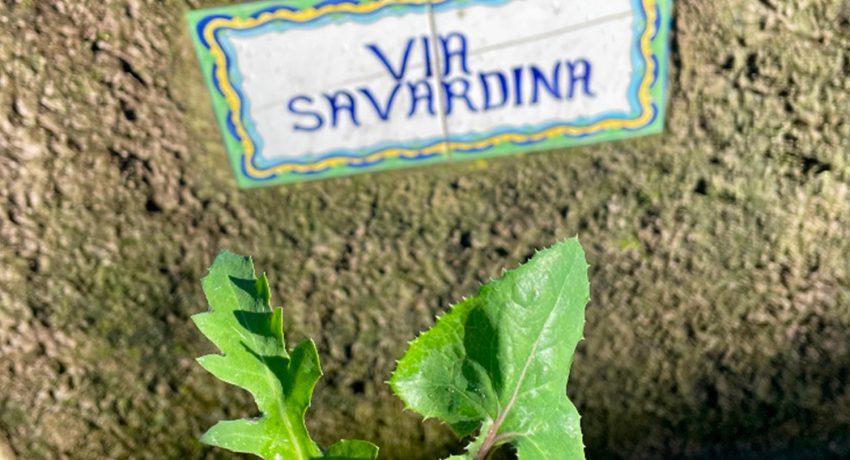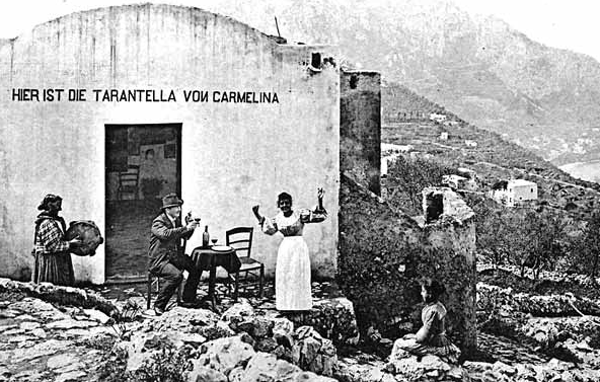

This historical research about Capri’s ancient cuisine was born on a January morning at La Conchiglia. The intent was to gather information on Pizza Monacone, but as often happens, research has made some wonderful turns that have taken it in a completely different direction.
In fact, that morning I was lucky enough to meet Riccardo Esposito in the bookshop, owner of the publishing house who, as an inexhaustible source of anecdotes, whetted my “hunger for knowledge” with stories flavored with Minestra Maritata and other Capri recipes.
Capri Island Documentary Center
Leaving the library, I came to the Documentary Center where I found Giuseppe Aprea welcoming me. I learned much more from that morning’s chats than from books. I understood that oral culture is fundamental concerning the food culture and I realized that I wanted to know all about it and to pass it on.
That morning the air was filled with the scents of conversations about Chiommenzana sauce (is the original one with oregano or without? The question is keenly debated) and with the scent of sweet onions, cooked for a long time, of a Pasta alla Poverella dish. Have you ever heard about them? The first consists in a sauce of fresh cherry tomatoes, wonderfully opened in a sauté of garlic and oil to release all their flavour. The second one is based on red onions and fried eggs pasta. They are home-made dishes, really poor in ingredients, but comforting such as a caress.
Two famous “Caprese” in the Twenty century
Which one is the original Capri cuisine? I’m starting to believe there is no answer, but we know two things for certain. It was a poor cuisine, a real art of getting by, and at the same time a composite cuisine. Since the dawn of time Capri’s recipes have seen the gastronomic traditions of the whole world grafted onto the island’s typical products. From Greek to Roman cuisine, from English to French domination: Capri has always tried to meet and marry the taste of its patrons, with a millenary spirit of hospitality.
During the 1900s were born the two dishes that bear the name “Caprese” and which are now famous all over the world: the Torta Caprese (of Russian/Austro-Hungarian origins, known in Capri as “Almond cake”) and the Insalata Caprese, a dish of tomato and mozzarella, cut into thick slices and dressed with plenty of olive oil and basil, freshly picked and scented with summer.
What did people eat in Capri’s houses? Chattering with Mrs. Luisa
Beyond these internationally renowned “twentieth-century” dishes, what did ordinary people eat on the island of Capri, in their own homes? Which were the ingredients available to everyone? To find out, I relied on the memory and stories of Mrs. Luisa, a Tiberian granny from Savardina. Signora Luisa’s father was a baker, her mother instead raised cows, pigs, hens and rabbits: she was the classic Capri woman of the past, the one who held the reins of the stable and the house, in a matriarchal regime.
The breeding of cows and pigs
On the island of Capri, cows were raised, Luisa tells me, for the milk they gave.
Luisa’s grandmother and her daughter then made a cheese from the raw milk, this, despite being cow’s and from Campania, was not mozzarella. Its name was Caciotta and it is the basis of some of the most important dishes in our cuisine: Capri Ravioli, for example.
The cow was therefore not bred for slaughter. Here the versions of Peppino and Luisa barely differ. At Signora Luisa’s house, the cow was slaughtered when it was too old to give milk. According to Peppino however, they never killed cows, they let them live until the animal felt to the ground of natural death and a herald, passing through the fields, gave the announcement.
The slaughterhouses on the island were in Anacapri, belonging to the Pollio family, which is still active in this business today.
Instead, the pig was the animal raised for meat. And for the bones and the blood, the paws and the tongue. As we know, nothing of the pig is thrown away, especially in a society as attentive to food resources as that of Capri was. Those who raised pork hardly ate it, says Mrs. Luisa. As a child, before going to school, she stopped by the Aurora restaurant and other inns every day to collect leftover food. She left it to his dad at the bakery, and him would take it home after work: it was used to feed the animals. So when the pig was killed it was necessary to return the favor: give one piece to one, one piece to another, the family that raised the animal was left with nothing but scraps. This is how the famous maritata soup of which I told you here was born (link).
Other farm animals: chickens and rabbits
The same thing happened to rabbits and chickens. The latter were raised for the eggs which were part of the daily diet of the island inhabitants, as evidenced by the “pasta alla poverella”.
Just when they became old they were killed and, as popular wisdom teaches, an invigorating broth was obtained. The rabbits were bred for sale, only a few remained for the family: the rabbit “alla caprese” tells me Luisa, is in white, with no tomatoes, or at most soiled with a couple of cherry tomatoes, a little pink. It has the flavor of the aromatic herbs of the Mediterranean flora: laurel, rosemary and marjoram and it must be spicy. The aromas of Capri’s dishes were strictly linked to the wonderful land in where they were born.
Quail: the jewel of Capri hunting
A different parenthesis must be opened for quail. I have often heard that Capri was an island of land and not of fishing and on this there is no doubt but… what about its game? There were numerous quails that passed through Capri during their migrations: they were hunted in the area known as “delle parate“, due to the nets set up for their hunting. The area that we now call “I due golfi” (two gulfs) overlooking Naples and Salerno. The booty of the hunting season, however, was very rarely consumed by hunters: it was mainly sold to wealthy Neapolitans or to Capri restaurateurs who, “removed” the meat from the game flavour with expert marinades, would serve them to their guests.
Hoping to make you mouth watering and to have intrigued you about the elements and the stories of the ancient island cuisine, I greet you, thank you Luisa, Peppino and Riccardo and I come back to writing!







Yet another, great satisfaction for the Da Tonino restaurant, which since 1993 has been giving

When attending an exhibition, a concert or even a private party, we generally do not

Mobility represents one of the most relevant challenges for modern cities today. There are realities

Preparations are underway for the new edition of That’s Amore Capri, an event that has

The past, present and future of Marina Piccola flow fast, like waves crashing on the

Sitting in the main dining room of La Capannina restaurant, pastel colors reminiscent of the
Power Up Capri-Roma – P.IVA: 09700821219 © 2022. All rights reserved. Design by Power Up Capri